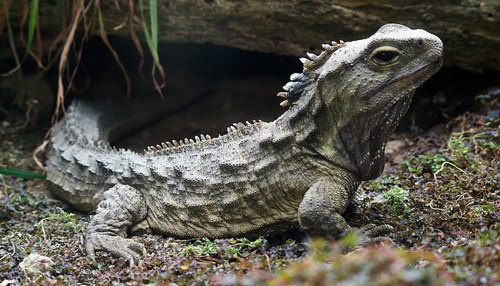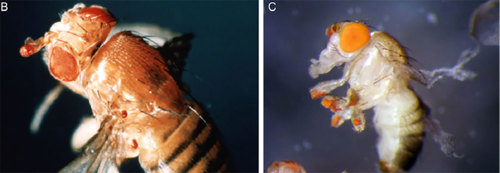
Is it possible to make a baby with 3 eyes?
March 3, 2006

- Related Topics:
- Quirky questions,
- Genetic engineering,
- Bioethics,
- Futuristic science,
- Editor's choice
A curious student from Montana asks:
“I was wondering if you could make a baby with 3 eyes. Is that possible?”
I'm not sure if it is possible in humans. But scientists can make animals that have more than their normal share of eyes. And there is even a lizard-like animal in New Zealand that naturally has three eyes.
This three-eyed animal is called a tuatara. The third eye of a tuatara, located on the top of its head, has all of the right parts: a lens, a retina, and nerves leading to the brain. But the eye is small and covered with scales, so it probably isn't really used for seeing. It might work as an ambient light sensor, though.

Fruit flies with extra eyes
Scientists have also created beasts with more than their usual number of eyes. Around 1935 or so, George Beadle managed to make a three-eyed fruit fly.1
As a fruit fly larva develops, it has something called eye buds. These eye buds eventually become eyes. What Dr. Beadle did was to move an eye bud from one larva and attach it to another larva. The end result was a fruit fly with three eyes.
Since then, things have gotten a lot fancier. In 1995, some Swiss scientists moved a gene around in a fruit fly and created eyes on the poor beast's antennae. And wings. And legs.2
If you think about it, this is pretty amazing stuff. Remember, a gene is a piece of DNA that tells a cell to do one thing, make a protein. And it takes more than one protein to make an eye.
So how did this single gene cause an eye to develop where it shouldn't? By being the master controller gene, PAX6.
Genes and eye development
A master controller gene turns on lots of other genes. Over 2000 different genes are needed to make an eye. In most of our cells, these genes aren't working or aren't being used to make an eye. Only if PAX6 starts the process of turning these genes on do you get an eye.
So when the master controller gene PAX6 was turned on in the antenna, all of the other 2000 or so eye genes got turned on too. The end result was an eye at the end of the antenna. The eye that was made had everything it needed to work. Except being hooked up to the right spot.
When they looked, scientists found that the eyes on the antenna were hooked up to the smelling part of the brain, not the seeing part (fruit flies use their antennae to "smell"). They are checking whether the fruit flies can now "smell" light.
So what do these examples tell us about your question? Well, the tuatara tells us that a third eye is possible naturally. Maybe three eyes were more common in the past or this was an evolutionary dead end. Either way, it can be done.

Could it work in humans?
The fruit fly experiments tell us how we could accomplish it in people. The eye bud experiment wouldn't work in people since we can't grow a baby outside of its mother. But the PAX6 experiment might.
This is because fruit flies and people use the same gene to start making eyes, the PAX6 gene. (In fact, the mouse PAX6 gene, which is identical to the human one, works to make eyes on a fruit fly's antenna.)2
The technical hurdles would be huge, though. You'd need to turn on the gene only where you wanted, not everywhere. We aren't very good at this yet in mammals although we are getting better.
And it goes without saying that the ethics of all of this are way beyond troubling. The number of embryos you'd have to go through to get it "right" would be appallingly high.
So even if scientists managed to grow a third eye on a person, would it work? Would it have the right connections to let you see? And even if it did, how would the brain process the information?

We see in stereo because we have two eyes. Imagine a third eye in the forehead like in a Twilight Zone episode.
Would our brains be able to triangulate on a target? Or would it see separate images so that you could see two things at once? Could you "smell" light if it were attached to the smelling part of the brain? Or hear light if it were hooked up to the hearing part of your brain? Who knows?
Of course this is all just a thought experiment at this point and no one would really do such a thing. The ethics are terrible and it isn't technically feasible at this point either. Thank goodness!

Author: Dr. Barry Starr
Barry served as The Tech Geneticist from 2002-2018. He founded Ask-a-Geneticist, answered thousands of questions submitted by people from all around the world, and oversaw and edited all articles published during his tenure. AAG is part of the Stanford at The Tech program, which brings Stanford scientists to The Tech to answer questions for this site, as well as to run science activities with visitors at The Tech Interactive in downtown San Jose.
 Skip Navigation
Skip Navigation
